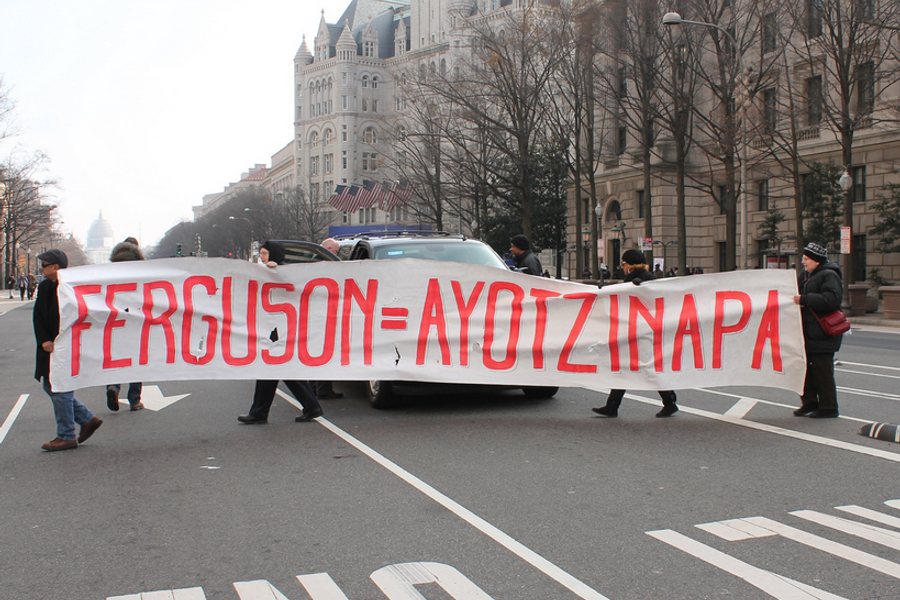From Ayotzinapa to Ferguson: Through an Eye Socket Darkly
The identified body of one of the 43 missing students from Ayotzinapa, Mexico, and the police killings of Eric Garner and Michael Brown in the U.S. reveal deep similarities between the two countries’ political classes.
Shannon Speed and Rosalva Aída Hernández

In early December, forensic experts conclusively identified one of the 43 missing students in Mexico through his eye socket. This charred bone fragment belonged to 19-year old Alejandro Mora, one of the students who disappeared after being detained by local police in Guerrero, Mexico, in September.
As anthropologists, we study violence in Mexico, and we learned this while gathered for our professional association meetings in Washington, D.C. The news was devastating — not just because it meant that he was dead, or even that there was a strong possibility that all the students were dead, but that the story told by the members of the Mexican criminal organization Guerreros Unidos was possibly true: that police turned the students over to them, and that they tortured the students, killed them and burned the remains.
The fervent hope of the students’ parents and of the hundreds of thousands of people who chanted in protests across the country and across the world day after day, “We want them back, and we want them alive,” was crushed under the weight of one charred eye socket.
Since that day December 6, we have learned that federal authorities had real-time information about the abduction and murder of the students, and did nothing to intervene. The bodies of three more dead youths have appeared, two of them students and one a 19-year-old nurse, the daughter of an activist.
The situation in Mexico is serious. But is the U.S. that much different?
The day we received the news about Alexander Mora, televisions throughout the conference hotel ran non-stop news broadcasts of protests in cities across the U.S. in response to the non-indictment of the white police officer in the choke-hold death of a black man, Eric Garner, in Staten Island, New York.
These joined the ongoing reports about protests in Ferguson, Missouri, and around the country over the killing of 18-year-old Michael Brown, who was black, and the acquittal of the white officer who shot him.
In fact, in both countries, news headlines have been dominated for months by stories of police violence, institutionalized racism and criminalization of social protest. In both countries, these events made obvious the disposability of those at the bottom of the social hierarchy. But the similarities run much deeper.
Both countries have been riveted by the massive mobilization of protest and the sustained outpouring of collective rage over the abuses, which are widely understood to be just the tip of the iceberg of authorized violence and impunity.
In both countries, official response to the wave of dissent has been repressive and violent, generating further anger rather than facilitating safe conditions for democratic dissent. Response to the protests in Ferguson, for example, entailed a display of force that looked a great deal like a war, leading to widespread alarm about the militarization of police forces in the U.S.
In both countries, official responses also reinforced impunity for the violations, further fueling collective anger. At times, these seemed almost timed to send the message that impunity will remain the status quo.
Grand juries refused to indict in either the Brown or the Garner killings, sending a clear message to the public that police will not be held accountable for the murder of black men. In the face of an appalling lack of progress of any kind on the investigation in Mexico, when the bone fragment was identified Mexico’s president, Enrique Peña Nieto, suggested publicly that the parents should “get over their grief.” His comment suggested that the public should move on, highlighting the reality that any real justice for the killing of the students is unlikely to be attained.
In both countries, frustration over official impunity led to extremes. In the Mexican state of Chiapas, an indigenous youth, frustrated over the arbitrary police detention of a community leader, lit himself on fire outside the offices of the state attorney general. He remains in critical condition. In New York, a mentally unstable man who expressed rage over the acquittal of the officers in the Brown and Garner cases, murdered two NYPD officers in Brooklyn.
In both countries, family members and protestors decried the public mischaracterization of the victims as criminals and subversives in attempt to justify their deaths. Brown was accused of having shoplifted a box of cigarillos. Garner was being arrested (by eight police officers) for allegedly selling loose cigarettes.
Official discussion in Mexico, particularly through the government-linked press, vilified the students as political “radicals” and their school as a hotbed of dissent.
Both countries have been strongly criticized by the United Nations, which has denounced both the repression against protestors and the events that generated the protests to begin with.
Both the U.N. Committee Against Torture and U.N. Committee on the Elimination of Racial Discrimination (CERD) slammed the U.S. for police violence against targeted populations, expressing “deep concern at the frequent and recurrent police shootings or fatal pursuits of unarmed black individuals.”
In a recent interview with The Guardian, the UN High Commissioner for Human Rights in Mexico, Javier Hernández Valencia, declared that it was clear that the students were victims of forced disappearance by government officials and warned that the parents of the 43 missing students were at risk given the “defamation campaign” being waged against them and their missing children.
Both countries find themselves at watershed moments, when change is being demanded from the ground up and from outside.
Change is possible. Yet neither country’s political class is demonstrating the needed leadership in response to the moment. Sadly, the U.S. mirrors Mexico in a number of ways, when viewed through an eye socket darkly.




